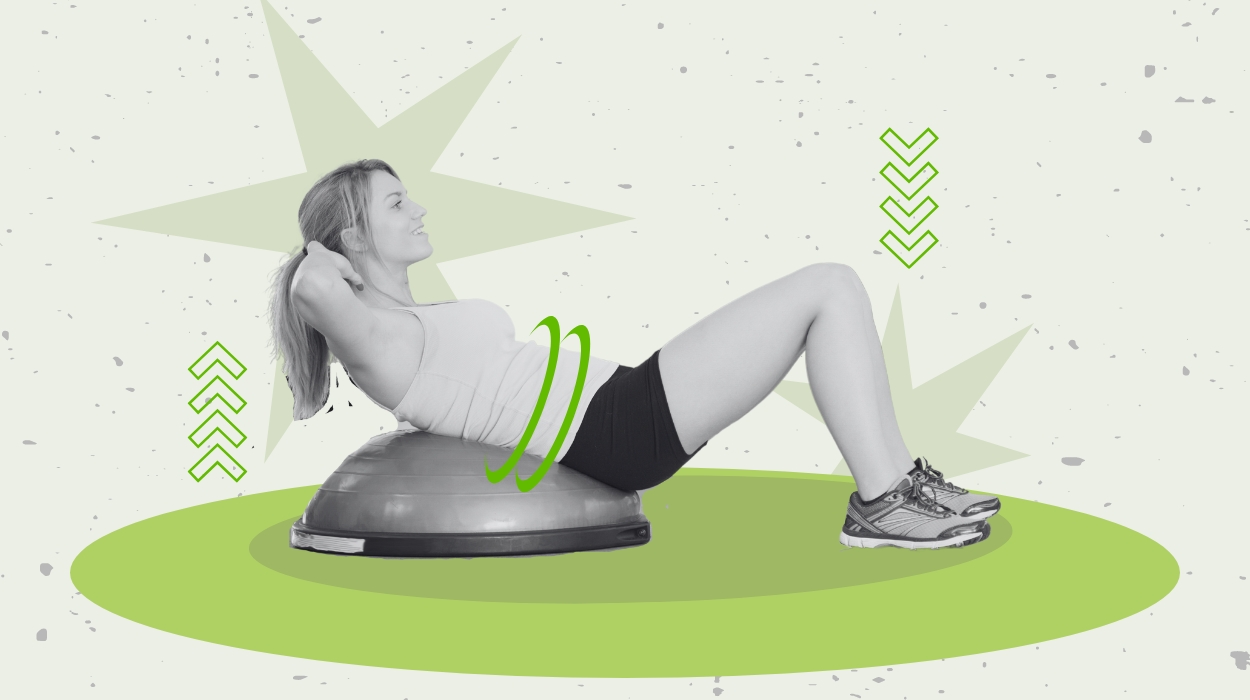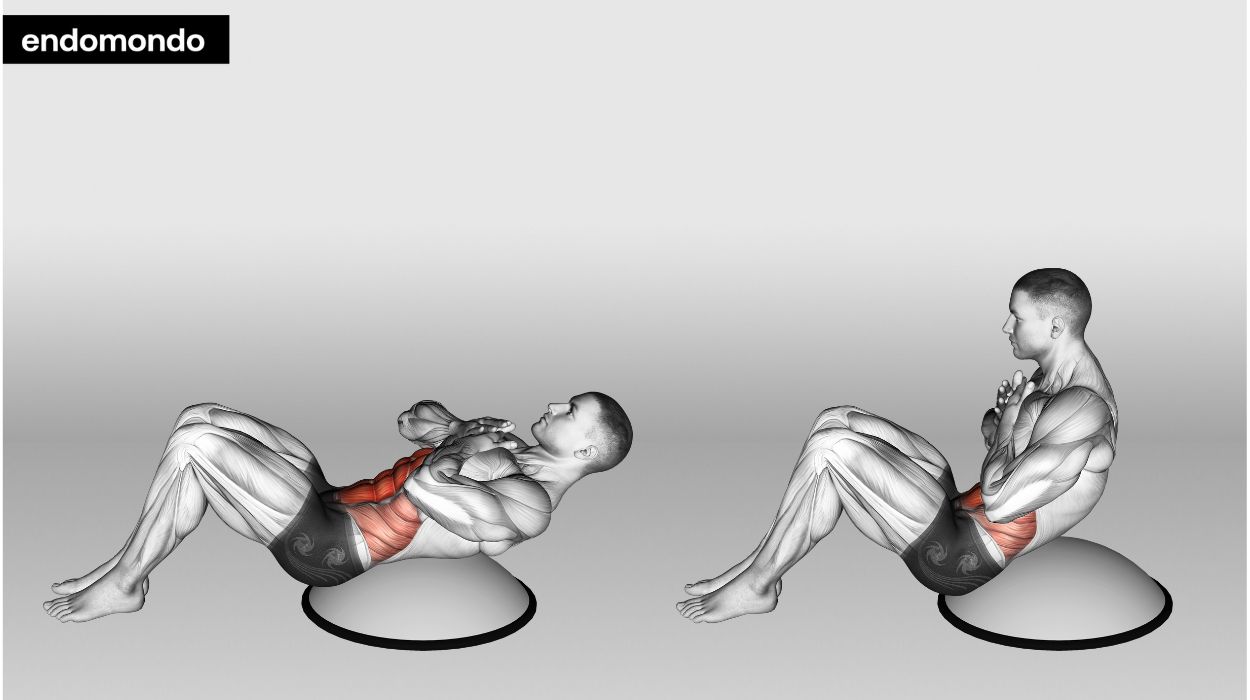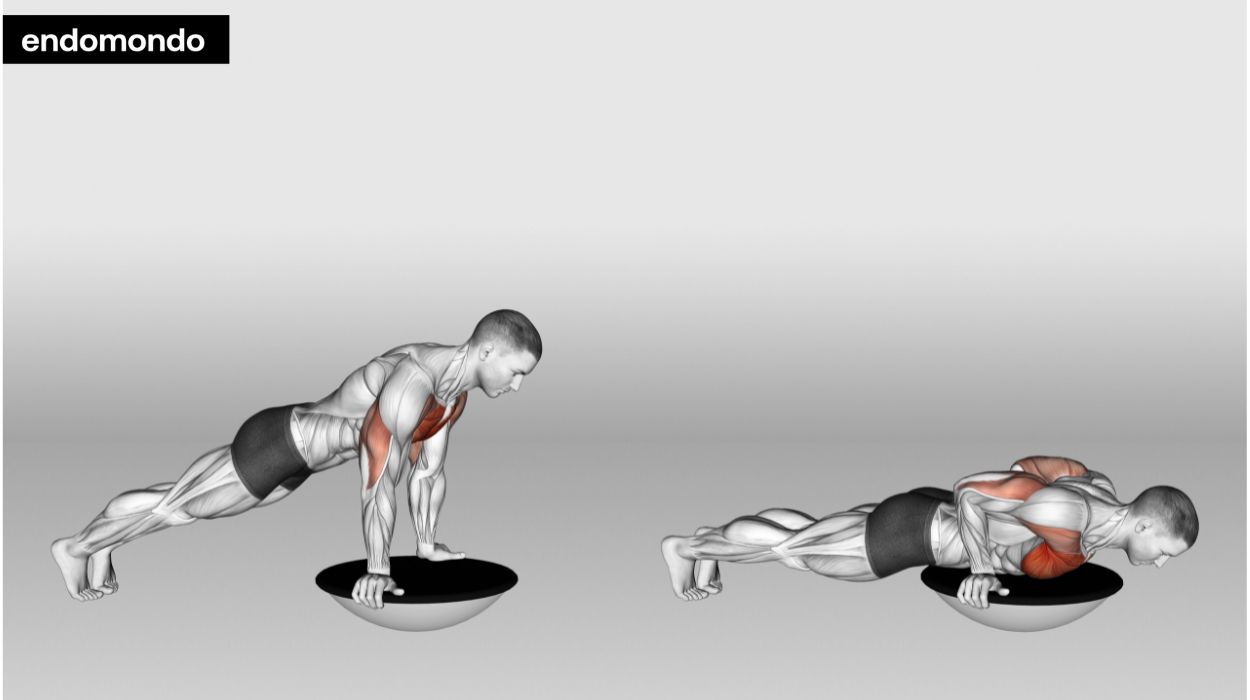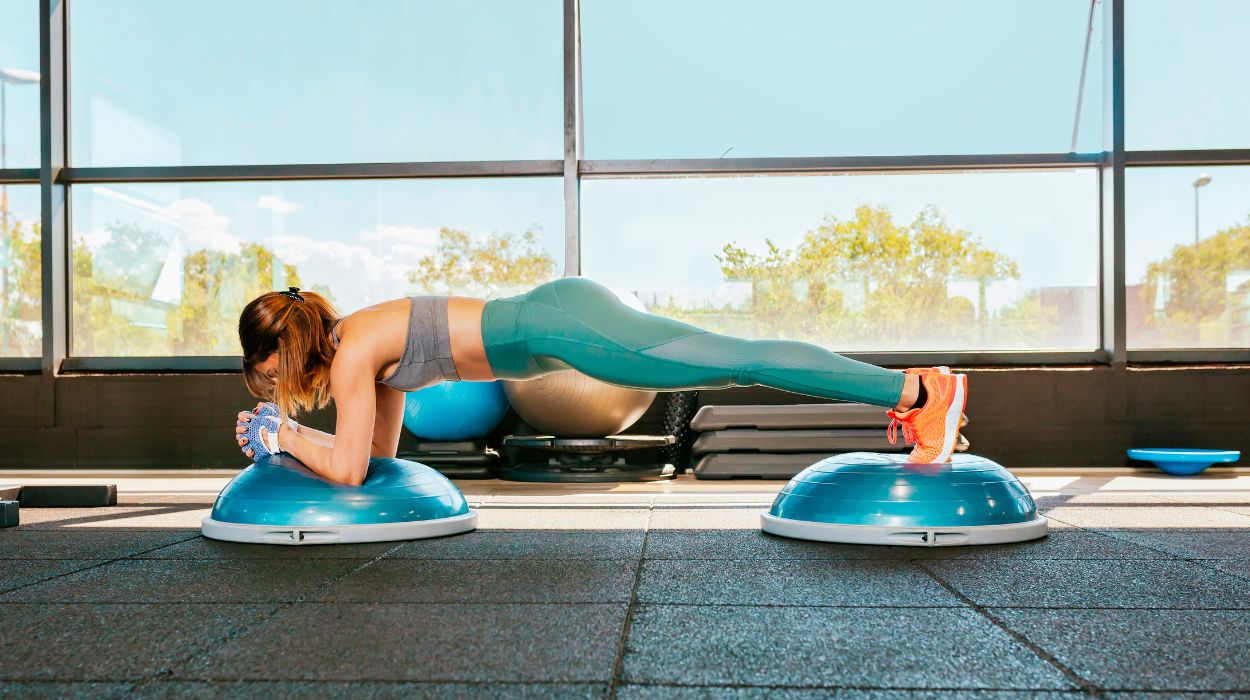
A bosu ball is a fitness tool that resembles a normal stability ball cut in half. The acronym created for this tool — both sides utilized or both sides up — provides both a flat surface and a dome-like round surface that can be used interchangeably depending on what specific workout you want to perform. They are perfect for making certain exercise ball ab exercises somewhat easier by providing slightly more stability.
Despite some skepticism from researchers, bosu balls can spice up a typical workout and provide a bonus challenge that adds to the benefits of the original. Also, performing bosu ball ab workouts can help amplify any effects you get from taking a fat burner for weight loss.
Here are some examples of effective bosu ball ab exercises.
Best Bosu Ball Ab Exercises To Improve A Strong Core
Here are eight exercises you can do with a bosu ball to strengthen your abdominals:
Bosu Ball Ab Exercises: Best Bosu Ball Core Exercises To Try
Bosu Planks
Nowadays, new exercise equipment leads to a variation of this classic isometric exercise, and the bosu ball is no exception. While the classic plank is scientifically proven to improve overall fitness,[1] and core strength, the bosu variation improves stability throughout your upper body strength. It’s also fairly simple for even beginners to do.
How to do:
- Place your bosu ball dome-side down on the floor.
- Go into the plank position with your hands on the sides of the ball’s rim. Keep your hands directly underneath your shoulders.
- Maintain a straight line throughout your body as you hold this position for 30 to 60 seconds.
Tips:
- Maintain a straight line from head to heels, engaging your core muscles to prevent sagging or arching of the back.
- Breathe steadily throughout the exercise, inhaling through your nose and exhaling through your mouth to maintain oxygen flow and stability.
- Avoid overarching your back or allowing your hips to sink, as this can strain the lower back and decrease the effectiveness of the exercise.
Optimal sets and reps: 3 sets of 30-60 seconds hold.
Bosu Twisting Planks
For those seeking a challenge, this bosu plank variation emphasizes toning your oblique muscles since it requires you to twist your hips.
How to do:
- Place your bosu ball dome-side down on the floor.
- Go into the plank position with your hands on the sides of the ball’s rim. Keep your hands directly underneath your shoulders, and engage your abs throughout the exercise.
- Cross your right knee toward your left shoulder, then return to the plank position.
- Switch sides and repeat with your left knee towards your right shoulder.
- Continue for each side.
Tips:
- Keep your body in a straight line from head to heels throughout the exercise, engaging your core muscles to stabilize the movement.
- Rotate your torso slowly and controlled, focusing on twisting from the waist without allowing your hips to sway.
- Avoid holding your breath; inhale as you twist to one side and exhale as you return to the starting position to maintain proper breathing and stability.
Optimal sets and reps: 3 sets of 10-15 reps on each side.
Bosu Plank Leg Lifts
This is yet another variation of the plank that can be performed on a bosu ball, with the main difference being that the added leg movements help tone your glutes and back in addition to your core.
How to do:
- Place your bosu ball flat-side down on the floor.
- Go into the plank position with your elbows on the dome’s center.
- Lift your left leg in the air, raising your left foot as you engage both your core and glutes.
- Lower your leg and switch sides to lift the other one.
- Continue for each side.
Tips:
- Maintain a stable plank position with your hands directly under your shoulders and your body forming a straight line from head to heels.
- Lift one leg at a time, focusing on engaging your core muscles to prevent your hips from tilting or rotating.
- Avoid arching your lower back or allowing your hips to sag; keep your core tight and your movements controlled throughout the exercise.
Optimal sets and reps: 3 sets of 8-12 leg lifts on each side.
Bosu Crunch
Crunches are considered another classic ab muscle exercise, but they only focus on the rectus abdominis while ignoring your obliques and other core muscles. Even if using a bosu ball also has your rectus abdominis as the main focus during crunches, bosu crunches can still help to strengthen your back for improved core stability and range of motion.

How to do:
- Place the Bosu ball flat-side down on the floor.
- Lay with the small of your back on the bosu ball, keeping your feet flat on the floor.
- Bring your hands behind your head. Your lower back should now be following the curve of the dome.
- Engage your core, then lift your shoulders and upper back off the dome as far as possible.
- Slowly return to the starting position.
- Repeat for the desired number of repetitions.
Tips:
- Lie on the bosu ball with your lower back supported and feet flat on the floor, maintaining a neutral spine to avoid strain.
- Exhale as you contract your abdominal muscles to lift your upper body off the ball, focusing on a controlled movement without using momentum.
- Keep your neck relaxed and avoid pulling on your head with your hands; instead, use your core strength to lift your torso.
Optimal sets and reps: 3 sets of 12-15 reps.
Bosu Ball Mountain Climbers
This variation of mountain climbers is another one of many bosu ball core exercises that also strengthen the arms and hamstrings. The bosu variation also works well as an aerobic exercise to improve cardiovascular health,[2] leading to efficient oxygen delivery throughout the body and ATP maintenance.
How to do:
- Place your bosu ball dome-side down on the floor.
- Go into the plank position with your hands gripping the sides of the ball’s rim. Keep your hands directly underneath your shoulders.
- Pull your left knee into your chest as far as you can. Return to the starting position.
- Switch legs – Pull your right knee into your chest while extending your left knee back.
Tips:
- Start in a plank position with your hands on the Bosu ball and your body forming a straight line from head to heels, engaging your core muscles to stabilize your body.
- Keep your shoulders directly above your hands and your hips level throughout the movement, avoiding any excessive sway or sagging of the lower back.
- Maintain a steady breathing pattern, exhaling as you drive your knees towards your chest and inhaling as you extend your legs back to the starting position.
Optimal sets and reps: 3 sets of 10-12 reps per side.
Bosu Bird Dog
The classic variation of this exercise focuses on strengthening your obliques to improve core stability,[3] but it also involves your entire body. Additionally, the bosu version of this exercise allows you to tone your glutes and lower back since it requires you to move your legs.
How to do:
- Place your bosu ball flat-side down on the floor.
- Get on all fours, with your hands on the ball and your knees on the floor.
- Extend your right leg behind you and your left arm in front of you simultaneously.
- As you draw both arm and leg back to the starting position, extend the opposite arm and leg.
- Move slowly, and continue switching sides for each side.
Tips:
- Begin in a tabletop position with your hands on the bosu ball and knees on the ground, ensuring your wrists are directly under your shoulders and your knees under your hips.
- Engage your core muscles to stabilize your spine and pelvis as you extend your right arm forward and left leg backward, maintaining a straight line from your fingertips to your toes.
- Avoid arching your back or allowing your hips to rotate as you perform the movement, focusing on keeping your torso stable and your movements controlled.
Optimal sets and reps: 2-3 sets of 10-12 reps per side.
Bosu Dead Bug
As gross as this core exercise may sound, the dead bug is still great for engaging your lower core and challenging your obliques. The bosu variation simply adds to the benefit by giving exercisers a new way to challenge their bodies.
How to do:
- Place your bosu ball flat-side down on the floor.
- Lie down on the ball with your back following the curve of the dome side. Bend both knees at 90 degrees and raise both arms with your fingertips pointing towards the ceiling.
- Extend your left leg forward and your right arm past your head simultaneously. Engage your core as you do so.
- Return both to the starting position before moving the opposing arm and leg the same way.
- Continue switching sides.
Tips:
- Start by lying on your back with your arms extended toward the ceiling, holding the bosu ball securely in both hands.
- Keep your lower back pressed firmly against the floor throughout the movement, engaging your core muscles to stabilize your pelvis and spine.
- Maintain steady breathing and avoid arching your back or letting your legs drop too low, focusing on controlled movements to maximize core engagement.
- Move slowly and deliberately to ensure proper form and muscle activation.
Optimal sets and reps: 2-3 sets of 10-12 reps on both sides.
Bosu Push-Ups
Classic push-ups are typically associated with your chest and arm muscles, but being able to do them while maintaining proper form also provides a challenge that can help strengthen your core muscles and your lower back. Adding a bosu ball makes it even more challenging for some, but it can be very effective if done properly.

How to do:
- Place your bosu ball dome-side down on the floor.
- Go into the plank position with your hands on the sides of the ball’s rim. Keep your legs straight with your toes on the floor.
- Push your body up off the bosu ball until your arms are straight, but do not lock your elbows.
- Hold this position for two seconds, then slowly lower your body back to the starting position.
- Repeat for the desired number of repetitions.
Tips:
- Begin in a plank position with your hands placed firmly on the flat side of the Bosu ball, shoulder-width apart.
- Engage your core muscles to maintain a straight line from your head to your heels throughout the movement, and exhale as you push back up to the starting position.
- Avoid sagging your hips or letting your lower back arch, and focus on controlled movements to maximize the effectiveness of the exercise.
- Adjust the difficulty by changing the angle of your body or adding stability challenges.
Optimal sets and reps: 2-3 sets of 8-12 reps.
Is Bosu Ball Good For Abs?

Hypothetically speaking, it should be. However, some research makes this claim less credible.
In one study,[4] researchers have found that strength training using an unstable surface such as a bosu ball can improve muscle strength and power more than on a stable surface, but only to some extent. Advantages regarding improving balance were barely present, likely due to lower force and power outputs associated with using unstable surfaces. In fact, another study shows[5] that the fewer repetitions you do on a bosu ball, the lower the instability and decrease in health benefits will be.
Even so, this does not mean you should avoid using a bosu ball altogether. Best bosu ball exercises — variations of classic exercises — can amplify the original version’s effects or allow for new improvements that the original does not.
Safety Precautions
For those who have never used a bosu ball, it may take some time to figure out how it works and how to use it properly. Do not rush learning how to use it; your body needs time to adjust to the ball’s instability.
Here are a few tips for using a bosu ball:
- While using the flat side for bosu ball balance exercises, be prepared to put your foot down to catch yourself from falling. You can also use a wall, chair, or bar.
- Keep your body in proper alignment at all times. You should never slump.
- Place a mat or folded towel underneath to serve as extra padding if you use it on a hard surface like wood.
Some other general pointers to remember:
- Do light warmups before you do any workouts and cool-downs afterward.
- Give your body a few days a week to rest and avoid harming your body.
- Consume a sufficient amount of calories and nutrients before exercising. Take supplements if you need to.
Conclusion
Bosu balls are somewhat underrated compared to more popular fitness tools like dumbbells. Even if a bosu ball on its own isn’t necessarily effective, the instability of this fitness tool allows for more challenging variations of upper ab workouts and lower ab workouts for those looking to take their workouts to the next level.
Frequently Asked Questions
A bosu ball is a fitness tool that resembles half of a typical balance ball, with a round dome on a flat platform.
They can strengthen your back and abdominal muscles.
You shouldn’t work out every day but give your body a break to rest and recover for the next workout.
Balancing on a bosu ball itself focuses more on improving balance, stability, and even cardiovascular health. This fitness tool merely allows for extra variations of normal muscle-building workouts.
Resources
- Park, S.-K., Lee, K.-S., Heo, S.-J. and Jee, Y.-S. (2021). Effects of High Intensity Plank Exercise on Physical Fitness and Immunocyte Function in a Middle-Aged Man: A Case Report. Medicina-lithuania, [online] 57(8), pp.845–845. doi:https://doi.org/10.3390/medicina57080845.
- Nystoriak, M.A. and Bhatnagar, A. (2018). Cardiovascular Effects and Benefits of Exercise. Frontiers in Cardiovascular Medicine, [online] 5(135). doi:https://doi.org/10.3389/fcvm.2018.00135.
- Hsu, S.-L., Oda, H., Saya Shirahata, Watanabe, M. and Sasaki, M. (2018). Effects of core strength training on core stability. Journal of Physical Therapy Science, [online] 30(8), pp.1014–1018. doi:https://doi.org/10.1589/jpts.30.1014.
- Behm, D.G., Muehlbauer, T., Armin Kibele and Urs Granacher (2015). Effects of Strength Training Using Unstable Surfaces on Strength, Power and Balance Performance Across the Lifespan: A Systematic Review and Meta-analysis. Sports Medicine, [online] 45(12), pp.1645–1669. doi:https://doi.org/10.1007/s40279-015-0384-x.
- Marquina, M., Jorge Lorenzo Calvo, Jesús Rivilla-García, García-Aliaga, A. and Refoyo, I. (2021). Effects on Strength, Power and Speed Execution Using Exercise Balls, Semi-Sphere Balance Balls and Suspension Training Devices: A Systematic Review. International Journal of Environmental Research and Public Health, [online] 18(3), pp.1026–1026. doi:https://doi.org/10.3390/ijerph18031026.




